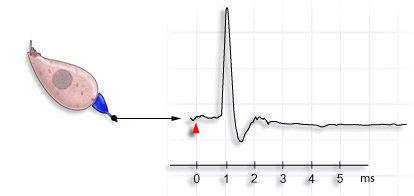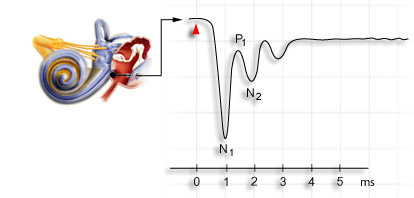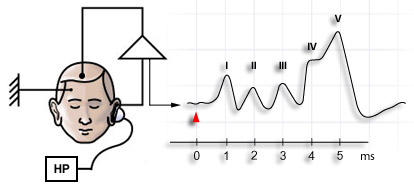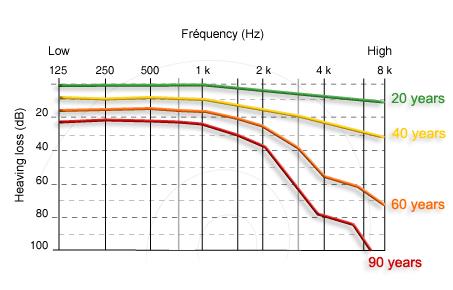| Overview / Cochlea / Auditory pathway / Audiograms | |
| Scientific concept: Jérôme Ruel, Jean-Luc Puel, Nuno Trigueiros Cunha | |
| Drawings: P. Minary, S. Blatrix |
| Hearing thresholds of an individual may be assessed by both objective and subjective methods. Objective methods are based on recordings of the electrical activity at various stages along the auditory pathway, from the cochlea to the cortex, and do not need the active participation of the individual. On the other hand, subjective methods need the co-operation of the individual being tested, because they rely on the subject's perception of and response to sound. |
| Objective Methods | |
| Auditory potentials reflect the electrical activity of the various neural pathways involved in the coding of sounds. Individual unitary potentials are recorded directly from a single cell or nerve fibre. Compound potentials, recorded at a distance from their origin, reflect the sum of the unit potentials. The following are three examples of different types of potentials : note the temporal concordance beween the different recordings - at whichever level being measured, the first wave recorded with a latency of 1 ms reflects the auditory nerve action potential. | |
Unit potentials |
|
 |
Recording of an action potential of a single auditory nerve fibre (experimental technique not used in humans) |
|
A glass micro-electrode (arrow) allows the recording of the electrical activity from a single neurone in the auditory nerve. This auditory fibre responds to sound stimulation (red dot) by sending an action potential (AP) towards the brain. The latency between the sound stimulus (red arrow) and the the AP is about 1ms. The amplitude of individual APs is measured in millivolts (mV). |
|
Electrocochleography |
|
 |
Recording of the compound cochlear nerve action potential at the Round Window This technique is used in human subjects, and is also known as electrocochleography |
|
|
|
Evoked Potentials |
|
 |
Brainstem Auditory Evoked Potentials (BAEPs) |
|
|
|
 |
|
|
x-axis : pure tone frequency (kHz); y-axis : hearing loss in dB.Age 20 (green curve) : normal audiogram, with a non-significant loss in the very high frequencies (8 kHz). Age 40 (yellow) : this high frequency loss is more obvious, but is not yet a handicap.Age 60 (orange) : the hearing loss is becoming significant (>40dB) at 4 kHz ; une gêne apparaît dans la compréhension : par ex. pour la perception des "sifflantes" et de leurs harmoniques.Age 90 (red), losses of > 40 dB are obvious in the middle frequencies (2 kHz), and hearing has significantly deteriorated. |
|
